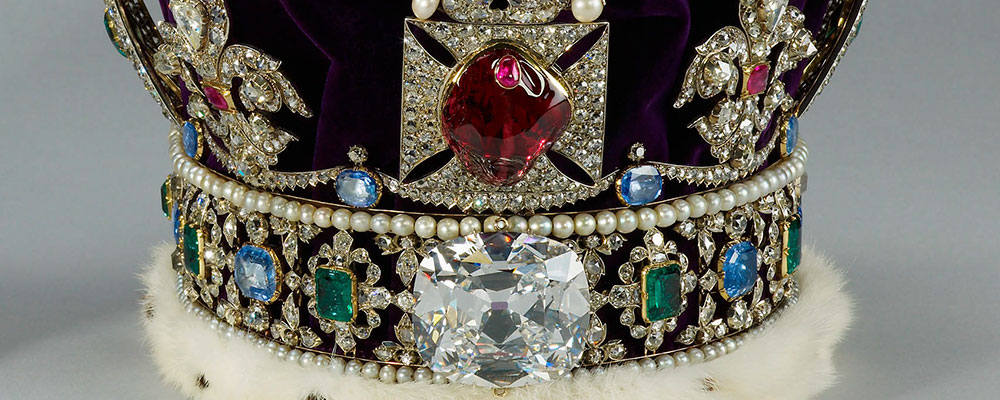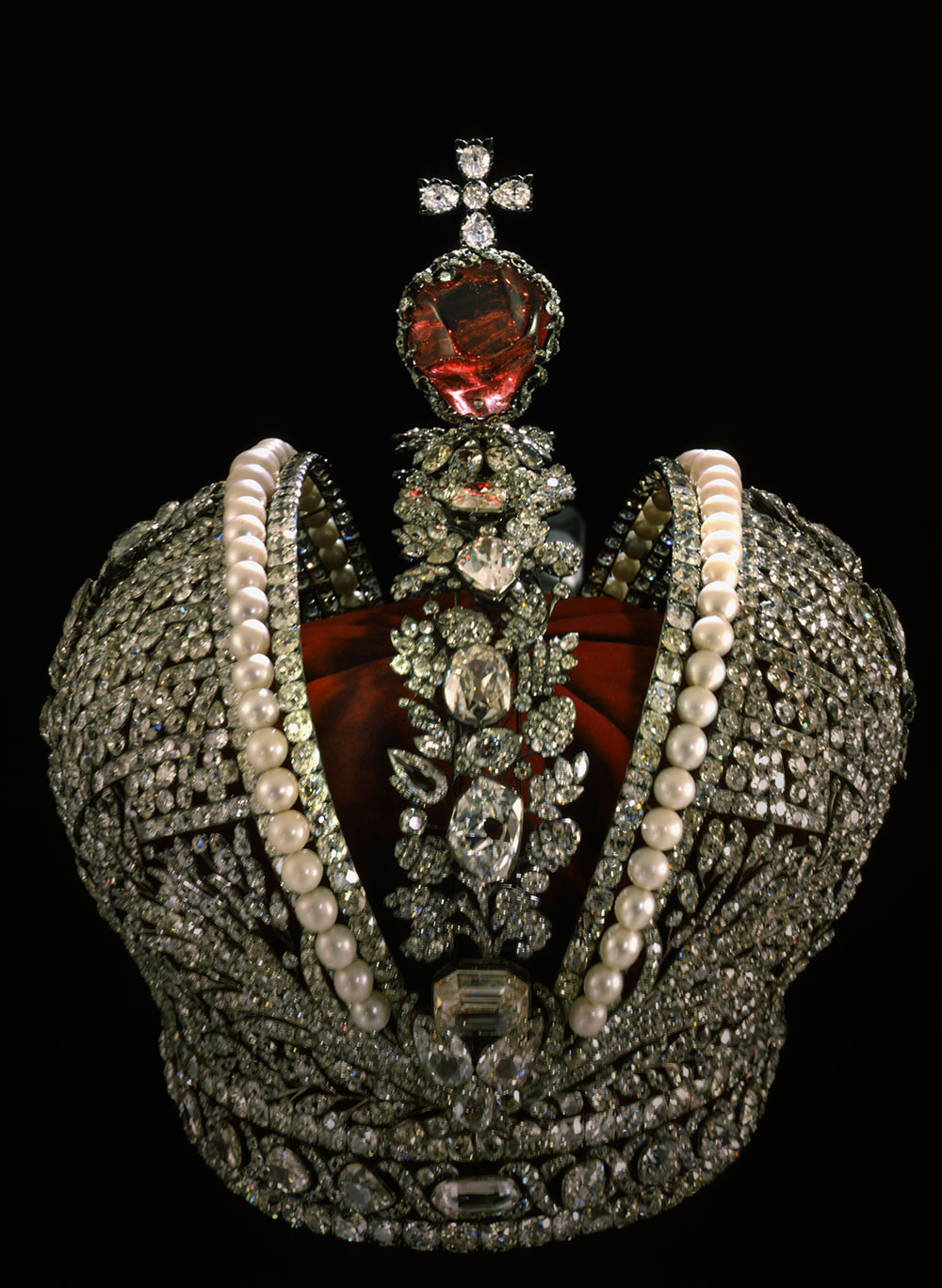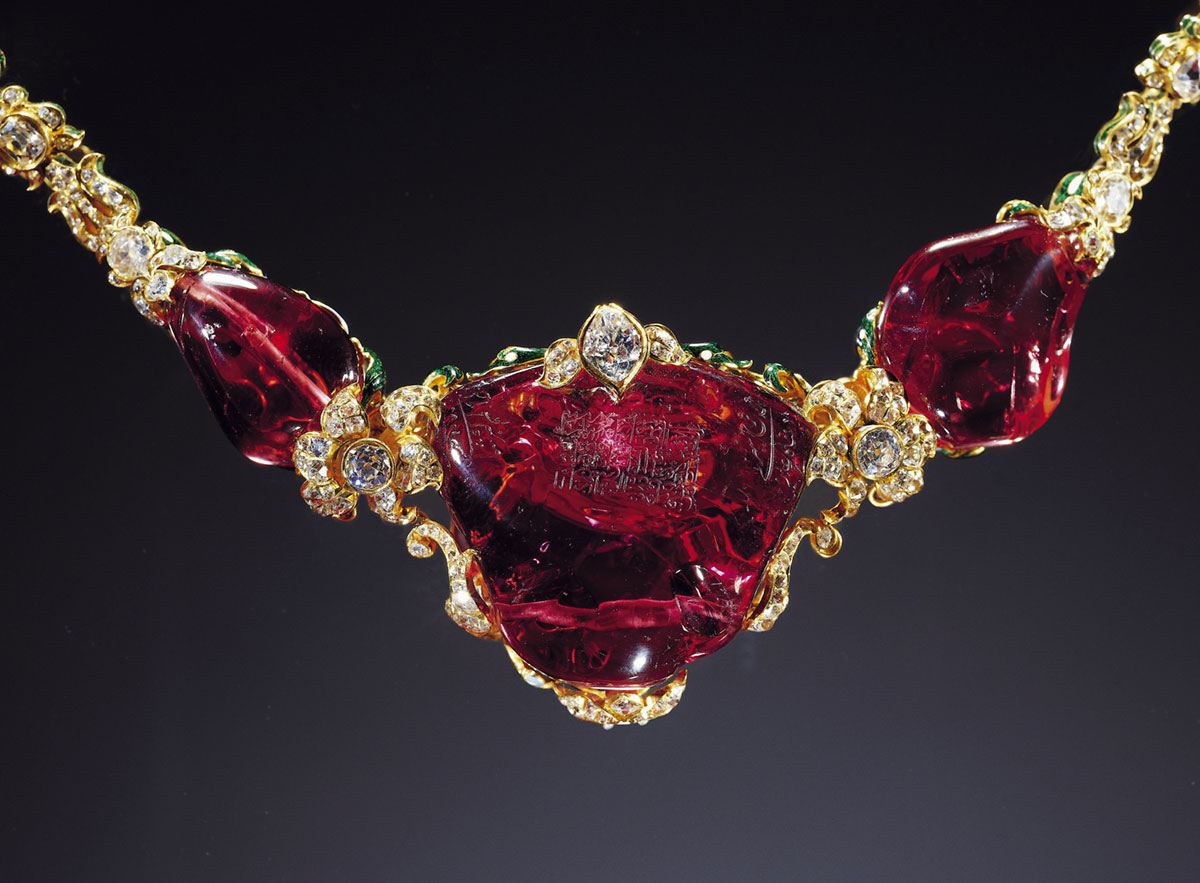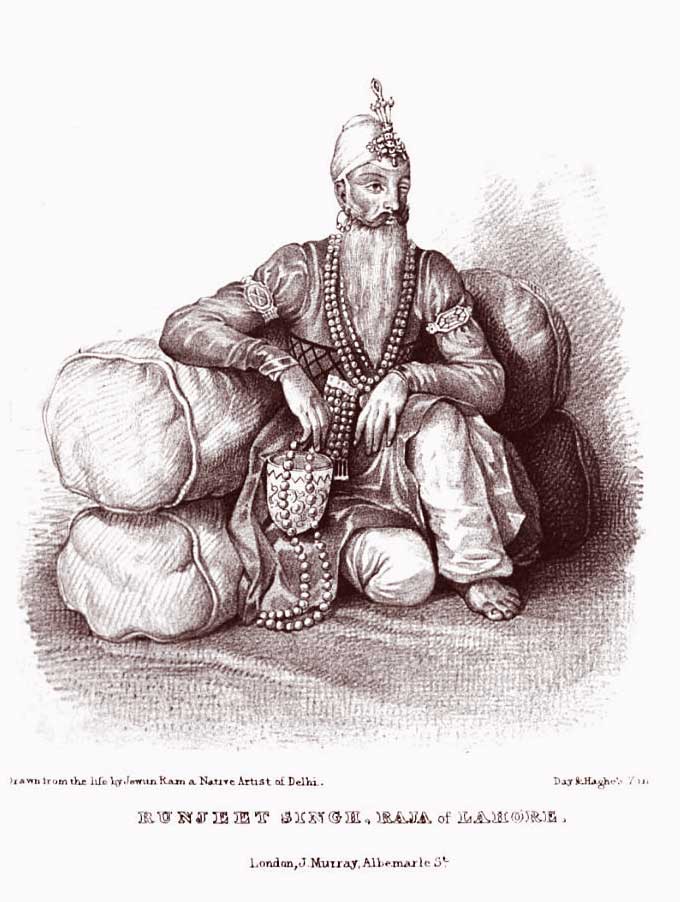The history of the Black Prince's Ruby, one of the world's most famous precious stones.
The Black Prince's Ruby
Few precious stones have such a long and storied history as the Black Prince's ruby, a large, semi-polished, crimson orb that today sits on the front of Britain's Imperial State Crown. The following account, largely taken from Richard Hughes' 1997 book, Ruby & Sapphire, tells the tale of this extraordinary gem.
Although the gem was probably mined at Kuh-i-Lal (Badakhshan's famous balas ruby mines) in what is now Tajikistan, the gem's first documented appearance is in fourteenth-century Spain. At that time, Spain was ruled by a number of petty kings, one of whom was a Moorish prince, Mohammed, of Granada. Don Pedro the Cruel ruled nearby Seville, and it was to him that Mohammed fled after being deposed by his brother-in-law, Abu Said. Don Pedro's army eventually brought Abu Said to heel. When they arrived to negotiate, Abu Said and his attendants were killed, and their jewels seized. The date was 1366. Among the jewels was a large red spinel octahedron, the size of an egg. It is today known as the Black Prince's Ruby.
Don Pedro soon found it his turn to flee, his adversary being none other than his own brother, Henry. In 1366, he fled to Bordeaux, where Edward of Woodstock (a.k.a. 'the Black Prince') kept court. Don Pedro beseeched the Black Prince to help, promising untold treasures in return. Henry was duly defeated and the large red stone passed as payment to the Black Prince, in 1367.
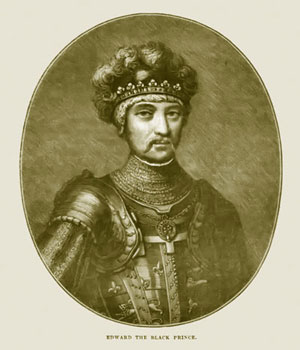 Edward, the "Black Prince." Illustration from Cassell (1902).
Edward, the "Black Prince." Illustration from Cassell (1902).
The gem reappeared in the hands of the English king, Henry V, at Agincourt, on Oct. 25, 1415. The gallant king, with his army reduced to 15,000 men, was falling back upon Calais when at Agincourt he encountered Duc d'Alençon, the French prince, and his army of 50,000 men. The morning of the climactic battle Henry appeared dressed in most splendid attire, with gilt armor. Upon his helmet was a crown garnished with rubies, sapphires and pearls, including the Black Prince's Ruby.
Henry's helmet was more than mere decoration, for on that day he was set upon by the French prince, Duc d'Alençon. The Frenchman struck his helmet a mighty blow with his battle axe, nearly killing Henry. Others also attacked him, even managing to break away a portion of the crown. Miraculously, though, both the stone and Henry survived. After the battle, a French prisoner retrieved the broken fragment and brought it back to England, an act for which he was duly reimprisoned. The identical helmet worn by Henry at Avincourt is said to reside in Westminster Abbey, shorn of its jewels. Two deep gashes are readily visible, bearing mute testimony to the gallantry of Henry V on that fateful day.
From here the precious gem passed through the hands of numerous British kings, including Henry VIII and his daughter, Elizabeth I, who kept it in her private collection. She did show it to a Scottish envoy, Sir James Melville, however. One evening the Queen took him into her bedchamber, where "she shewed me a fair ruby, great like a racket-ball. I desired she would either send it to my queen [Mary, Queen of Scots] or the Earl of Leicester's picture. She replied 'If Queen Mary would follow her counsels she would get them both in time and all she had, but she would send a diamond as a token by me.'" It was for the Black Prince's Ruby that the envoy begged, but Mary was destined to get neither.
King James I had the stone set in his state-crown, for the Earl of Dorset describes the stone in an inventory of the crown jewels. His description of the imperial crown concludes: "and uppon the topp a very greate ballace [balas ruby, or spinel] perced." We know this to be our stone for at some point in time it had been drilled ('perced') at the top with a small hole, so as to be worn suspended from the neck, a common occurrence with oriental gems. Today this hole is capped with a small ruby.
After the coronation of Charles I, by a fortunate occurrence, the great gem was not placed in the jewel house along with the other royal treasures. If it had it would have been lost, for when Cromwell took power and Charles I was executed, all the treasures found there were either melted down or sold by order of the Commonwealth. Among the priceless pieces thus lost was the gold filigree crown of Edward the Confessor, which was broken up and sold for its weight of bullion. Orpen (1890) remarked… "Such vandalism is almost enough to make one a Jacobite."
But the Black Prince's Ruby was not among them. According to the Parliamentary sales list of Charles I's Crown Jewels, there is an entry recording the sale, for £4, of a "perced balas ruby wrapt in paper by itself", which several authors have identified as the Black Prince's Ruby. Sitwell (1953) believes that this is incorrect, and that the Black Prince's Ruby is more likely to have been that identified as the Rock Ruby, which sold for £15.
In any event, in 1660 it was bought by an unknown party, who resold it to Charles II after the restoration of the Stuarts (Michael, 1983). During the reign of Charles II, the stone, by now set in Charles II's State Crown, had another narrow escape. It was nearly stolen by the notorious Colonel Blood, who, unbelievably, was later pardoned by the King.
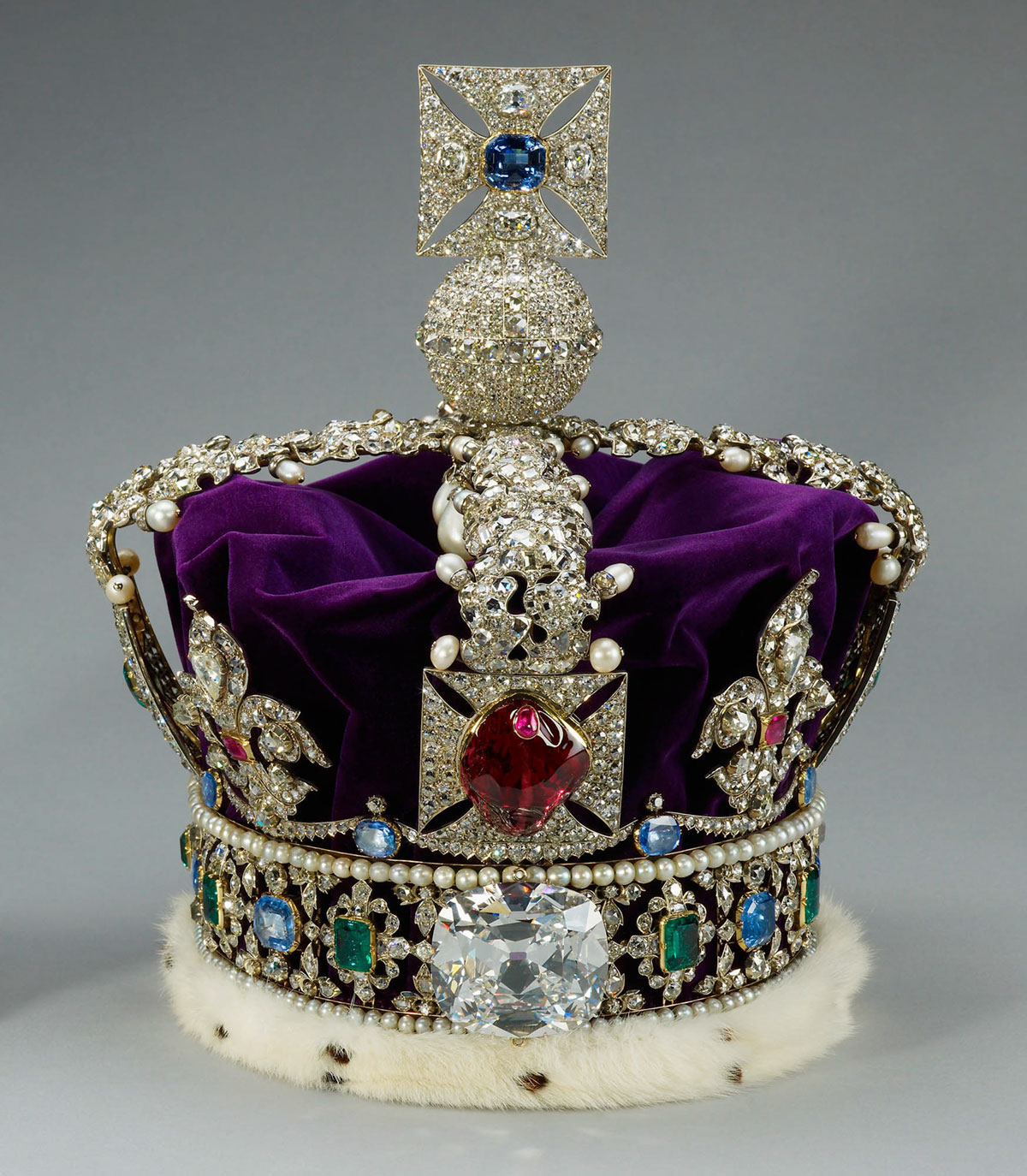 Perhaps the world's most famous gem, the Black Prince's Ruby (front, center), is actually a large red spinel. Its history is documented back to 1366 AD. Today it is mounted on the front of Britain's Imperial State Crown, which is located in the Tower of London. Britain's Imperial State Crown contains more famous gems than virtually any other ornament in the world, including the Black Prince's Ruby, the Stuart Sapphire (not visible), St. Edward's Sapphire (on top) and the Cullinan II diamond (below the Black Prince's Ruby).
Perhaps the world's most famous gem, the Black Prince's Ruby (front, center), is actually a large red spinel. Its history is documented back to 1366 AD. Today it is mounted on the front of Britain's Imperial State Crown, which is located in the Tower of London. Britain's Imperial State Crown contains more famous gems than virtually any other ornament in the world, including the Black Prince's Ruby, the Stuart Sapphire (not visible), St. Edward's Sapphire (on top) and the Cullinan II diamond (below the Black Prince's Ruby).
Once again, in 1841, the crown was almost lost, this time by fire. Only the quick actions of police inspector Pierse saved the day. As the Tower burned, Pierse broke through the iron bars with a crowbar to rescue these irreplaceable objects. Again, during World War II, the royal regalia was once more in danger, this time from Hitler's bombers. However, they survived undamaged and today the giant Black Prince's Ruby can be viewed in all its glory in the Tower of London, along with the rest of the English Crown Jewels.
 The notorious Col. Thomas Blood, who tried to steal the Black Prince's Ruby. From Abbott (1910)
The notorious Col. Thomas Blood, who tried to steal the Black Prince's Ruby. From Abbott (1910)
The Black Prince's Ruby is today mounted in the front of the Imperial State Crown, just above the famous Cullinan II Diamond. It is a huge, semi-polished octahedron with three faces. Sitwell (1953) states that the stone is backed by a gold foil, as were many ancient gems, to improve its brilliance. This has not been removed for fear of damaging the gem. The stone measures some two inches (5.08 cm) in length and is of proportionate width (Younghusband, 1919). Its exact weight is unknown, but estimates put it at ~170 ct As earlier stated, it is drilled at one end and a small ruby is set atop the opening. It was drilled during the Middle Ages for use as a pendant. Today a small ruby covers up the entrance to the drill hole. On the back of the mounting is a small plaque recording the recent history of the crown.
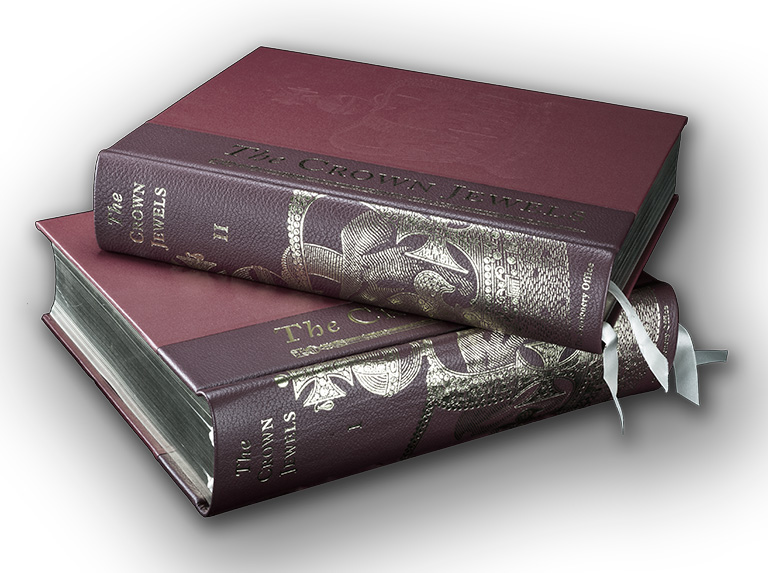 Blair et al.'s The Crown Jewels from 1998. This two-volume set is the best reference on Great Britain's crown jewels. Sadly, only 650 copies were printed. Photo: Wimon Manorotkul
Blair et al.'s The Crown Jewels from 1998. This two-volume set is the best reference on Great Britain's crown jewels. Sadly, only 650 copies were printed. Photo: Wimon Manorotkul
In the late 1990's, a comprehensive study on the British Crown Jewels was undertaken (Blair et al., 1998). Sadly the results were only published in a massive two-volume set limited to 650 copies. While the author is fortunate to own a set, one hopes that this work, which is really the property of all humanity, will be released at some stage to a wider audience.
According to Younghusband (1919), "the question is often asked: 'What is the value of this stone?' And the answer may safely be given that it is priceless, for no amount of money can buy it." It is indeed the most famous gemstone in the world's most famous gem collection.
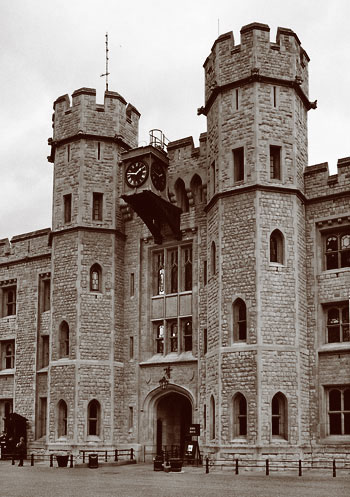 Entrance to the Jewel House at the Tower of London. Photo: Wikimedia
Entrance to the Jewel House at the Tower of London. Photo: Wikimedia
|
A 19th Century account of the balas ruby mines Budukhshan has acquired great celebrity for its ruby mines, which were well known in early times, and also to the emperors of Delhi. They are said to be situated on the verge of the Oxus, near Shughnan, at a place called Gharan.* They are dug in low hills; and one man assured me that the galleries passed under the Oxus; but I doubt the information. It is a mistake to believe that they are not worked, as the present chief at Koondooz employed people in them since he conquered the country. These persons had been hereditarily engaged in that occupation; but, as the returns were small, the tyrant of Koondooz demanded their labour without pay; and on their refusing to work, he marched them to the unhealthy fens of Koondooz, where their race has almost become extinct. In the search of rubies, it is a popular belief that a pair of large ones will always be found together; and the workmen will often conceal a gem till its match can be found, or break a large ruby into two pieces. The rubies are said to be imbedded in limestone, like round pieces of pebble or flint, which exist in such deposits. In the vicinity of these mines, great masses of lapis lazuli are found on the verge of the Oxus. The mode of detaching it from the cliffs appears ingenious, though I think that I have heard of similar means 'being used to quarry stone in other quarters. A fire is lit over the block of lapis lazuli, and when the stone becomes sufficiently heated, cold water is dashed upon it, and the rock is thus fractured. The lapis lazuli of the Oxus was sent in former years to China; but the demand has lately decreased. I have seen many specimens of this stone, with veins, which were said to be gold; but I imagine they were mica. The search for lapis lazuli and rubies is only prosecuted in winter. *Gharan may simply mean caves or mines, since such is the signification of the word in Persian. |

References & further reading
- Abbott, W.C. (1910) Colonel Thomas Blood: Crown Stealer—1618–1680. Rochester, NY, Genesse Press.
- Aziz, A. (1942) The Imperial Treasury of the Indian Mughuls. Lahore, privately published, reprinted 1972 by Idarah-I Adabiyat-I Delli, Delhi, 572 pp.
- Aziz, A. (1947) Arms and Jewellery of the Indian Mughuls. The Mughul Indian Court and its Institutions, Lahore, Ripon Press, 159 pp.
- Aziz, A. (n.d.) Thrones, Tents and their Furniture used by the Indian Mughuls. The Mughul Court and its Institutions, Lahore, privately published, 145 pp.
- Bala Krishnan, U.R. (2001) Jewels of the Nizams. New Delhi, Dept. of Culture, Govt. of India in association with India Book House, Mumbai, 240 pp.
- Ball, V. (1893) A description of two large spinel rubies, with Persian characters engraved upon them. Proceedings of the Royal Irish Academy, Vol. 3, No. 1, pp. 381-401, reprinted in Gemological Digest, 1990, Vol. 3, No. 1, pp. 57–68. <http://www.palagems.com/spinel_ball.htm>
- Blair, C., Bury, S. et al. (1998) The Crown Jewels: the History of the Coronation Regalia in the Jewel House of the Tower of London. London, The Stationery Office, 2 Vols., 812, 630 pp.
- Bowersox, G.W. and Chamberlin, B. (1995) Gemstones of Afghanistan. Tucson, AZ, Geoscience Press, xx, 172 pp.
- Burnes, A. (1834–1835) Travels into Bokhara. London, John Murray, 3 Vols., 2nd ed., see Vol. 3, pp. 177–178.
- Cassell (1902) Cassell's History of England – Century Edition.
- Christie's (1997) Important Indian Jewelry. London, Christie's, 143 pp.
- Christie’s (1999) Important Indian Jewels. London, Christie’s, 6 October 1999, 96 pp.
- Christie’s (1999) Magnificent Mughal Jewels. London, Christie’s, 6 October 1999, 182 pp.
- Collins, R. (1968) East to Cathay: The Silk Road. New York, McGraw-Hill, 128 pp.
- Fersman, A.E. (1946–47) Jewels of the Russian Diamond Fund. Gems & Gemology, Trans. by Marie Pavlovna Warner, Vol. 5, Part I: No. 8, Winter, pp. 363, 372–376; Part II: No. 9, Spring, pp. 403–405; Part III: No. 10, Summer, pp. 432–434; Part IV: No. 11, Fall, pp. 467–470.
- Hendley, T.H. (1909) Indian Jewellery. London, W. Griggs & Sons, Reprint of articles from the Journal of Indian Art from 1906–1909, reprinted 1984 by Cultural Pub. House, Delhi; 1991 by Low Price Publications, Delhi, 189 pp., many plates.
- Hughes, R.W. (1994) The rubies and spinels of Afghanistan: A brief history. Journal of Gemmology, Vol. 24, No. 4, October, pp. 256–267.
- Hughes, R.W., Pardieu, V., Soubiraa, G. & Schorr, D. (2006) Moon Over the Pamirs: Chasing ruby and spinel in Tajikistan.
- Keene, M. and Kaoukji, S. (2001) Treasury of the World: Jeweled Arts of India in the Age of the Mughals. New York, Thames & Hudson, 160 pp.
- Kievlenko, E.Y. (2003) Geology of Gems. English edition edited by Art Soregaroli. Ocean Pictures Ltd., 432 pp.
- Latif, M. (1982) Bijoux Moghols—Mogol Juwelen—Mughal Jewels. Bruxelles, Société Génerale De Banque, 212 pp.
- Michael of Greece, P. (1983) Crown Jewels of Europe. New York, Harper & Row, reprinted 1990 by Peerage Books as Crown Jewels of Britain and Europe, 144 pp.
- Orpen, G. (1890) Stories about Famous Precious Stones. Boston, Lothrop, 286 pp.
- Prinsep, J. and Kalíkishen, R. (1832) Oriental accounts of the precious minerals. Journal of the Asiatic Society of Bengal, Vol. 1, pp. 353–363.
- Prior, K. and Adamson, J. (2000) Maharajas' Jewels. New York, Vendome Press, 205 pp.
- Sitwell, H.D.W. (1953) The Crown Jewels and Other Regalia in the Tower of London. London, Dropmore Press, 116 pp.
- Stronge, S. (1996) The myth of the Timur ruby. Jewellery Studies, Vol. 7, pp. 5–12.
- Twining, L. (1960) A History of the Crown Jewels of Europe. London, B.T. Batsford, 707 pp.
- Untracht, O. (1997) Traditional Jewelry of India. New York, Harry N. Abrams, 1st ed., 432 pp.
- Yevdokimov, D. (1991) A ruby from Badakhshan. Soviet Soldier, No. 12, Dec., pp. 71–73.
- Younghusband, G. and Davenport, C. (1919) The Crown Jewels of England. London, Cassell and Co., Ltd., 84 pp.
About the author
Richard W. Hughes is one of the world’s foremost experts on ruby and sapphire. The author of several books and over 170 articles, his writings and photographs have appeared in a diverse range of publications, and he has received numerous industry awards. Co-winner of the 2004 Edward J. Gübelin Most Valuable Article Award from Gems & Gemology magazine, the following year he was awarded a Richard T. Liddicoat Journalism Award from the American Gem Society. In 2010, he received the Antonio C. Bonanno Award for Excellence in Gemology from the Accredited Gemologists Association. The Association Française de Gemmologie (AFG) in 2013 named Richard as one of the fifty most important figures that have shaped the history of gems since antiquity. In 2016, Richard was awarded a visiting professorship at Shanghai's Tongji University. 2017 saw the publication of Richard's Ruby & Sapphire: A Gemologist's Guide, arguably the most complete book ever published on a single gem species and the culmination of nearly four decades of work in gemology.

